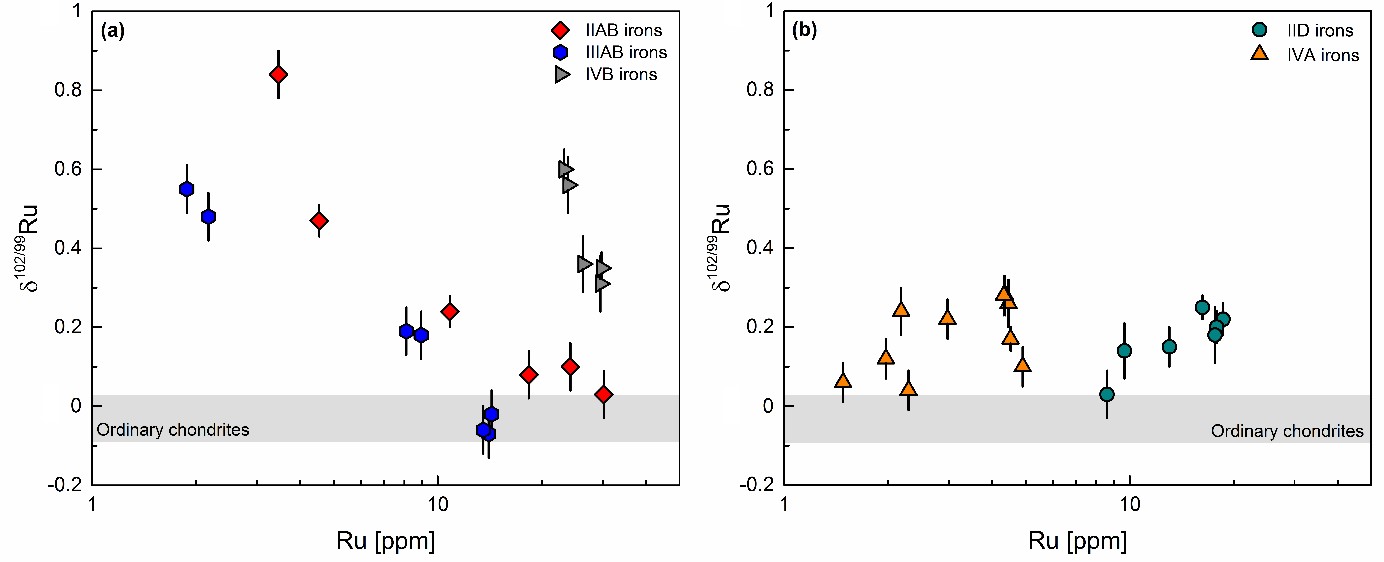Current research work (Subproject B2)
(a) Ruthenium stable isotopic constraints on crystallization of protoplanetary cores
Mass-dependent Ru isotope variations (δ102/99Ru) and Ru concentrations were determined for 35 magmatic iron meteorites from the five major chemical groups (IIAB, IID, IIIAB, IVA, IVB). In addition, four equilibrated ordinary chondrites were analyzed. The IIAB, IIIAB and IVB iron meteorites display increasingly heavier Ru isotopic compositions with decreasing Ru content. Modeling demonstrates that the trends for these three iron groups can be reproduced by the incremental extraction of isotopically lighter Ru into solids, which leads to progressively heavier δ102/99Ru in the remaining melt. The modeling further shows that the Ru isotopic variations of the IIAB and IIIAB irons are consistent with derivation from parental melts with an ordinary chondrite-like δ102/99Ru, whereas the IVB irons more likely derive from a melt with heavier δ102/99Ru. This heavy Ru isotopic composition of the IVB parental melt probably results from high-temperature processing of the IVB precursor material. The Ru isotope systematics of the IID and IVA irons are more complex and show no correlation between δ102/99Ru and Ru content. Although most samples exhibit heavy Ru isotopic compositions, especially the late-crystallized irons of these groups deviate from the expected fractional crystallization trends. This deviation most likely results from mixing and re-equilibration of early-crystallized solids and late-stage liquids, followed by further fractional crystallization. The mixing might be related to the migration of liquids through a complex network of dendrites or to the overturn of a cumulate inner core, and bears testimony to the complex solidification history of at least some protoplanetary cores.
Hopp, T., Fischer-Gödde, M., Kleine, T. (2018) Ruthenium isotope fractionation in protoplanetary cores. Geochimica et Cosmochimica Acta 223, 75-89. https://doi.org/10.1016/j.gca.2017.11.033
(b) Ruthenium stable isotopic constrains on late accretion onto Earth
The suprachondritic Ru/Ir of the Earth’s mantle suggests that the late veneer did not consist of known chondrites, was a mixture of chondrites and iron meteorites [1], or that Ru was incompletely removed from the mantle during sulfide segregation (‘Hadean matte’) at the end of core formation [2]. To distinguish between these different scenarios, we obtained mass-dependent Ru isotopic data for a comprehensive set of iron meteorites, chondrites and mantle peridotites from Earth. Our data reveal large δ102/99Ru variations among iron meteorites, and show that Earth's mantle has a chondritic δ102/99Ru. These data rule out a significant contribution of evolved iron meteorites (which have heavy δ102/99Ru) to the late veneer, and suggest that either there was no Ru isotope fractionation during sulfide segregation or that a fractionated signature was overprinted by the late veneer.
[1] Fischer-Gödde M. and Becker H. (2012) GCA 77, 135-156. [2] Rubie D. et al. (2016) Science 353, 1141-1144.
Results from Hopp et al. (2018)

- Hopp, T., Fischer-Gödde, M., Kleine, T., 2017. ‘Ruthenium isotope fractionation in the solar nebula.’ Contributed to the 48th Lunar and Planetary Science Conference, The Woodlands, Houston, USA.
- Hopp, T., Fischer-Gödde, M., Kleine, T., 2017. ‘Ruthenium stable isotopes: Insights into the crystallization of protoplanetary cores and the late accretion history of the Earth’ Contributed to the 2th Accrete Workshop, Nice, France.
- Hopp, T., Fischer-Gödde, M., Kleine, T., 2017. ‘Ruthenium stable isotopes and the late accretion history of the Earth’ Contributed to the Goldschmidt Conference, Paris, France.
- Hopp, T., Fischer-Gödde, M., Kleine, T., 2017. ‘Ruthenium stable isotopic constraints on late accretion’ Contributed to the Paneth Kolloquium, Nördlingen, Germany.
- Hopp, T., Fischer-Gödde, M., Kleine, T., 2016. „Ruthenium isotope fractionation during planetesimal core crystallization.“ contributed to the 47th Lunar and Planetary Science Conference 2016, Houston, TX, USA.
- Hopp, T., Fischer-Gödde, M., Kleine, T., 2016. ‘Ruthenium isotope fractionation in planetesimal cores.’ Contributed to the 4th International HSE Geochemistry Workshop, Durham, UK.
- Hopp, T., Fischer-Gödde, M., Kleine, T., 2016. ‘Ruthenium isotope fractionation during crystallization of planetesimal cores.’ Contributed to the 79th Meeting of the Meteoritical Society, Berlin, Germany.
2018
Hopp, T., Fischer-Gödde, M., Kleine, T., 2018: Ruthenium isotope fractionation in protoplanetary cores. Geochimica et Cosmochimica Acta 223, 75-89, 10.1016/j.gca.2017.11.033
2016
Hopp, T., Fischer-Gödde, M., Kleine, T., 2016: Ruthenium stable isotope measurements by double spike MC-ICPMS. Journal of Analytical Atomic Spectrometry 31, 1515-1526, 10.1039/c6ja00041j

